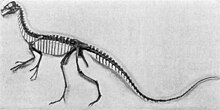Ornitholestes: Difference between revisions
range and synonym |
ErikHaugen (talk | contribs) show maniraptora |
||
| Line 9: | Line 9: | ||
| parent_authority = [[Henry Fairfield Osborn|Osborn]], 1903 |
| parent_authority = [[Henry Fairfield Osborn|Osborn]], 1903 |
||
| authority = Osborn, 1903 |
| authority = Osborn, 1903 |
||
| display_taxa = 3 |
|||
| synonyms = |
| synonyms = |
||
* ''[[Coelurus]] hermanni'' <small>(Osborn 1903) [[Oliver Perry Hay|Hay]], 1930 |
* ''[[Coelurus]] hermanni'' <small>(Osborn 1903) [[Oliver Perry Hay|Hay]], 1930 |
||
Revision as of 05:11, 5 December 2010
| Ornitholestes Temporal range: Late Jurassic,
| |
|---|---|
| Scientific classification | |
| Missing taxonomy template (fix): | Ornitholestes hermanni |
| Synonyms | |
Ornitholestes (meaning "bird robber") was a small theropod dinosaur of the late Jurassic of Western Laurasia (the area that was to become North America). To date, it is known only from a single partial skeleton, and badly crushed skull found at the Bone Cabin Quarry near Medicine Bow, Wyoming, in 1900.[1] It was described by Henry Fairfield Osborn in 1903.[2] An incomplete hand[1] was later attributed to Ornitholestes, although it now appears to belong to Tanycolagreus.[3] The type (and only known) species is O. hermanni. The species name honors the American Museum of Natural History preparator Adam Hermann.
Description
Ornitholestes was roughly 2 meters (6.5 ft) in length.[4] The head of Ornitholestes was relatively small.[5] Nonetheless, the skull was more robust than that of many other small theropods, such as Compsognathus and Coelophysis, and this would have enabled Ornitholestes to deliver a powerful bite.[6] In 1988, Gregory S. Paul suggested the presence of a small horn on the snout of Ornitholestes, similar to that of Proceratosaurus.[5] However this was disproved by Ken Carpenter and colleagues in 2005, who found that the 'crest' was actually a broken nasal bone.[3] Paul later updated his depositions to reflect this discovery.[7]
Like most other theropods, Ornitholestes had a long tail, presumably used for balance.[8]
Discovery

This section needs expansion. You can help by adding to it. (December 2009) |
Ornitholestes fossils were found in in stratigraphic zone 2 of the Morrison Formation (Salt Wash member). Remains possibly referrable to Stokesosaurus have been recovered from stratigraphic zone 5 of the Morrison Formation.[9]
Classification

Ornitholestes was a coelurosaur, similar in many ways to Compsognathus, though somewhat larger. In 1988, Gregory S. Paul coined the name Ornitholestinae for a subfamily family of small theropods including Ornitholestes, which he considered allosaurids. However, phylogenetic studies of dinosaur relationships later proved that this was an unnatural grouping. Ornitholestes is sometimes found to be a basal maniraptoran, and other putative ornitholestids are not closely related to it.
Diet
The sharp teeth of Ornitholestes clearly identify it as a carnivore, but its exact diet has been a subject of debate in the paleontological community.
In his original 1903 description, Henry Fairfield Osborn suggested that Ornitholestes might have preyed on contemporary birds, based on the "rapid grasping power of agile and delicate prey" suggested by the structure of the hand.[10] In 1917, however, Osborn reevaluated the hand and determined that it was unsuitable for this purpose.[11]
More recently, Robert T. Bakker speculated that Ornitholestes probably hunted small mammals, noting that "the Como furballs were just the right size to fit the predator's jaws."[12]
In popular culture
It appeared in the 1999 BBC Walking with Dinosaurs and the 2000 special The Ballad of Big Al
References
- ^ a b "Ornitholestes." In: Dodson, Peter & Britt, Brooks & Carpenter, Kenneth & Forster, Catherine A. & Gillette, David D. & Norell, Mark A. & Olshevsky, George & Parrish, J. Michael & Weishampel, David B. The Age of Dinosaurs. Publications International, LTD. p. 76. ISBN 0-7853-0443-6.
- ^ Osborn, Henry Fairfield (1903). "Ornitholestes hermanni, a new compsognathoid dinosaur from the Upper Jurassic" (pdf). Bulletin of the American Museum of Natural History. 19 (12): 459–464.
- ^ a b Carpenter, Kenneth (2005). "Redescription of the small maniraptoran theropods Ornitholestes and Coelurus from the Upper Jurassic Morrison Formation of Wyoming". In Carpenter, Kenneth (ed.) (ed.). The Carnivorous Dinosaurs. Bloomington: Indiana University Press. pp. 49–71. ISBN 0-253-34539-1.
{{cite book}}:|editor=has generic name (help); Unknown parameter|coauthors=ignored (|author=suggested) (help) - ^ Norman, David (1988). The Illustrated Encyclopedia of Dinosaurs. Gramercy Books. p. 39. ISBN 0-517-46890-5.
- ^ a b Paul, Gregory (1988). Predatory Dinosaurs of the World. Simon and Schuster. p. 306. ISBN 0-671-61946-2.
- ^ Norman, 42
- ^ Paul, G.S. (2010). The Princeton Field Guide to Dinosaurs. Princeton University Press.
- ^ Osborn, Henry Fairfield (1917). "Skeletal adaptations of Ornitholestes, Struthiomimus, Tyrannosaurus". Bulletin of the American Museum of Natural History. 35. American Museum of Natural History: 734.
{{cite journal}}: External link in|title= - ^ Foster, J. (2007). "Appendix." Jurassic West: The Dinosaurs of the Morrison Formation and Their World. Indiana University Press. pp. 327-329.
- ^ Osborn 1903, 459
- ^ Osborn 1917, 733-734
- ^ Bakker, Robert (1986). The Dinosaur Heresies. Kensington Publishing Corp. p. 98. ISBN 0-806-52260-7.
